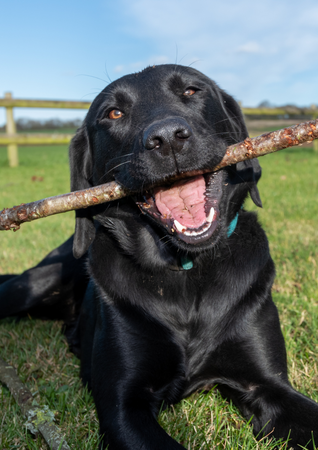Labrador Retriever

Breed history
The Labrador Retriever, often referred to simply as the Labrador or Lab, originated in Newfoundland, Canada. Originally bred as working dogs for fishermen, Labradors excelled at retrieving nets and ropes from the water due to their excellent swimming skills and strong build. They were later refined in England, where their friendly nature and intelligence made them popular as both hunting companions and family pets.
Life expectancy
Labrador Retrievers have an average life expectancy of 10 to 12 years. With proper care, a healthy diet, regular exercise, and regular veterinary check-ups, some Labs can live even longer.
Size
Labs are a medium to large breed. Adult males typically stand between 22.5 to 24.5 inches (57 to 62 cm) at the shoulder, while females are slightly smaller, ranging from 21.5 to 23.5 inches (55 to 60 cm). In terms of weight, adult Labs usually weigh between 55 to 80 pounds (25 to 36 kg).
Variations
Over time, Labs have developed slight variations based on their intended roles. Show labs often have a more stocky build and a calmer temperament, requiring substantially less exercise and stimulation than their working or field counterparts. Field labs tend to be leaner and more energetic, suitable for activities like hunting and retrieving.

Exercise & Training
Field Labrador Retrievers can be highly energetic dogs that require plenty of exercise to keep them happy and healthy. The show variety are much more sedentary and are happy with a slower pace of life. With either variety you should still expect to provide daily walks, playtime, and activities like fetching.. Their intelligence (and food drive) makes them relatively easy to train, but early and consistent training is key to preventing behavioral issues
Grooming/Shedding
Labs have a short, dense double coat that comes in three standard colors: black, yellow, and chocolate. With one slightly newer variation of fox red. They shed consistently throughout the year, with increased shedding during seasonal changes. They do not need clipping but regular brushing helps manage shedding and keeps their coat healthy. They only need occasional baths unless they get particularly dirty.

Common traits
Labrador Retrievers are known for their friendly and outgoing nature. They are highly social dogs that tend to get along well with people, children, and other pets. Their intelligence, eagerness to please, and trainability make them great candidates for various activities including service work, therapy, search and rescue, and obedience competitions.
Common health problems
While Labs are generally healthy dogs, they are prone to certain health issues like obesity, hip and elbow dysplasia, eye conditions, and allergies. Regular gentle exercise, a balanced diet, and routine veterinary care can help mitigate these risks. Another common problem is due to their high food drive. Labradors are the one of the most common breeds of dog that will eat a non digestible item. Things such as socks, underwear, tennis balls, stones. These objects can cause a small intestinal obstruction. This condition is life threatening unless treated surgically by the vet. This can be a common and expensive problem that labrador owners run into.
Pros
-
Friendly and Loving: Labs are known for their affectionate nature and strong bond with their families.
-
Versatile: They excel in various roles such as family pets, service dogs, and working companions.
-
Intelligent: Their intelligence and willingness to learn make them easy to train for various tasks.
-
Good with Children: Their gentle disposition makes them excellent with kids.
Cons
-
Shedding: Labs shed year-round and can leave hair all over the house.
-
Energetic: While their energy is a pro, it can be a challenge for those who can’t provide enough exercise or stimulation.
-
Mouthiness: Labs have a tendency to chew on objects, especially when they are bored or teething.
-
Need for Attention: Labs thrive on companionship and may develop behavioral issues if left alone for extended periods.
In conclusion, Labs are beloved for their friendly nature, intelligence, and versatility. As long as their exercise, training and health needs are met, they can make wonderful additions to families and individuals seeking an active and loving canine companion.
.png)



